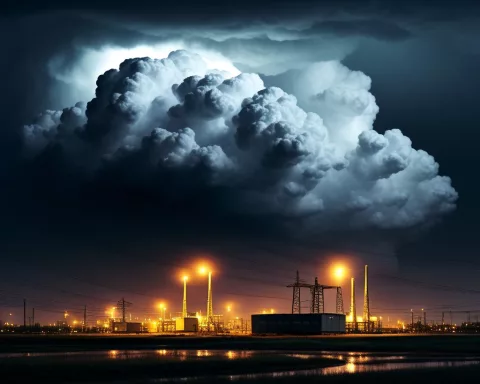South Africa is facing a tough energy crisis, with frequent power outages and problems at its main electricity provider, Eskom. Recently, the government assured people that these issues would be resolved soon. Despite the challenges, including old power stations and technical failures, there is hope as leaders work on solutions to stabilize the power supply. The journey ahead is not easy, but there’s a strong commitment to creating a brighter and more reliable energy future for everyone in the country.
What are the main challenges in South Africa’s energy crisis?
South Africa’s energy crisis is primarily characterized by ongoing load-shedding, technical failures in power generation, and aging infrastructure. Key challenges include restoring malfunctioning units at Eskom, ensuring operational efficiency, and addressing public frustration while transitioning to sustainable energy solutions.
A Critical Juncture in Energy Management
South Africa finds itself at a pivotal moment concerning its energy landscape, marked by both significant challenges and looming hope. Recently, during a press briefing, Electricity and Energy Minister Dr. Kgosientsho Ramokgopa reassured citizens that the ongoing load-shedding crisis is expected to resolve by the end of the week. Accompanied by Eskom executives, the Minister took the opportunity to address the nation directly, aiming to clarify the current situation and outline the pathway to resolution.
The reintroduction of Stage 6 load-shedding at 01:30 on a Sunday morning has become an unwelcome recurrence for South Africans. This extreme measure came in response to unforeseen setbacks, including the malfunction of several vital generation units. Despite enjoying a remarkable streak of 300 days with uninterrupted power, these recent interruptions laid bare the fragile equilibrium Eskom is striving to uphold in its operations.
Dr. Ramokgopa conveyed a message of optimism when he asserted, “I’m confident that by the end of the week, we should be out of this difficult situation.” He stressed the abnormal nature of load-shedding, highlighting the government’s steadfast commitment to reinstating normalcy. The Minister’s assurances arise amidst significant technical challenges plaguing Eskom, particularly at the Majuba and Camden power stations.
Technical Hurdles and Expert Insights
Eskom’s CEO, Dan Marokane, provided further clarity on the technical issues at hand. Among the ten units lost overnight, six have been successfully restored. The loss of multiple units at the Majuba power station was traced back to an overload on a transformer, which triggered a series of failures. This scenario echoes issues faced by power utilities globally when managing complex systems.
These technical intricacies are not isolated incidents but are part of a larger narrative affecting energy infrastructures worldwide. Power grids, akin to complex orchestras, necessitate seamless harmony among all components. At Majuba, an overload during the startup of a unit initiated a domino effect, causing further disruptions. Marokane emphasized dedicated efforts to identify and address the root causes, ensuring future occurrences are minimized.
Beyond the immediate technical challenges, Dr. Ramokgopa’s apology struck a chord with a nation wearied by power outages. Acknowledging public frustration, he stated, “The levels of agitation, levels of anger and disappointment are understood.” Recognizing public sentiments is vital for leadership, especially in tackling issues with profound socio-economic impacts.
Strategic Approach and Global Context
The government’s strategy, as delineated by the Minister, aligns with an Energy Action Plan introduced by the President in July 2022. This plan prioritizes enhancing Eskom’s operational efficiency. Dr. Ramokgopa also dismissed any theories of sabotage, urging the public to concentrate on technical solutions rather than speculative rumors.
The complexities of load-shedding in South Africa are indicative of broader global energy challenges. Nations around the world wrestle with aging infrastructure, increasing demands, and the transition to sustainable energy sources. South Africa’s dedication to overcoming these challenges reflects a shared global struggle, yet also presents an opportunity for resilience and innovation.
Stability for Eskom involves not only technical remedies but also a comprehensive reevaluation of its system design. Marokane mentioned plans for in-depth investigations into system vulnerabilities, signaling a proactive stance essential for long-term resilience.
Historical Context and Future Perspectives
Looking back, South Africa’s energy landscape has transformed significantly since the early 20th century. Reliance on coal-fired power stations has driven industrial growth but has also introduced environmental and operational challenges. The current drive for a more reliable grid aligns with global shifts towards cleaner, sustainable energy solutions.
Energy infrastructure rarely receives the same admiration as art or architecture. However, there exists a certain artistry in the seamless operation of a power grid. Each substation, transformer, and power line plays a crucial role in a grand choreography of electricity distribution. Recent disruptions serve as a poignant reminder of this intricate dance and the ongoing need for vigilance and innovation.
As Eskom works to restore stability, the insights gained will likely shape future strategies. The focus remains on ensuring that load-shedding becomes a relic of the past, an anomaly in the annals of South Africa’s energy history.
The Road Ahead for South Africa
As South Africans look to the future, the narrative of overcoming energy challenges continues to unfold. It is a story of resilience, technical expertise, and the unwavering commitment of those charged with powering the nation. The journey ahead may be fraught with challenges, but the destination promises a brighter, more reliable future for all.
FAQ on South Africa’s Energy Crisis
What are the main challenges in South Africa’s energy crisis?
South Africa’s energy crisis is primarily marked by ongoing load-shedding, technical failures in power generation, and aging infrastructure. Key issues include restoring malfunctioning units at Eskom, ensuring operational efficiency, and addressing public frustration during the transition to sustainable energy solutions.
How is the South African government addressing the energy crisis?
The government has introduced an Energy Action Plan prioritizing the enhancement of Eskom’s operational efficiency. Electricity and Energy Minister Dr. Kgosientsho Ramokgopa has reassured citizens that the ongoing load-shedding crisis is expected to resolve soon, emphasizing a commitment to restoring normalcy and addressing technical challenges.
What are the recent developments regarding Eskom’s operations?
Recent developments include the reintroduction of Stage 6 load-shedding due to unforeseen setbacks, such as the malfunction of several crucial generation units at Eskom. However, Eskom’s CEO has reported that six out of ten lost units have been successfully restored, and efforts are being made to address the root causes of these failures.
How is the public reacting to the ongoing power outages?
The public has expressed significant frustration and disappointment regarding the frequent power outages. Minister Ramokgopa has acknowledged these sentiments, highlighting the importance of understanding public agitation while working towards resolving the issues at hand.
What is Eskom’s long-term strategy for improving stability?
Eskom’s long-term strategy involves not only technical solutions but also a comprehensive reevaluation of its system design. Plans for in-depth investigations into system vulnerabilities and a commitment to minimizing future occurrences of load-shedding are part of this strategy.
How does South Africa’s energy crisis compare to global challenges?
South Africa’s energy crisis reflects broader global challenges, such as aging infrastructure and the transition to sustainable energy sources. While many nations face similar issues, South Africa’s dedication to overcoming these challenges presents an opportunity for resilience and innovation in its energy sector.












